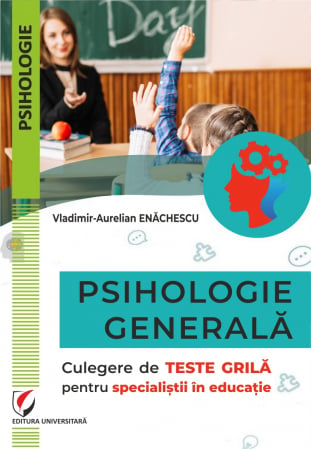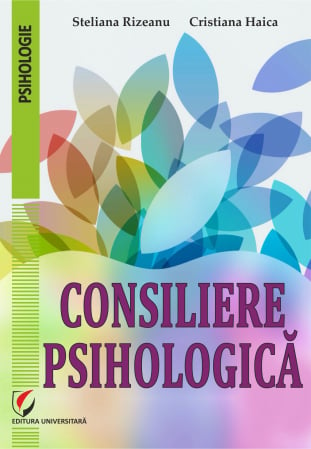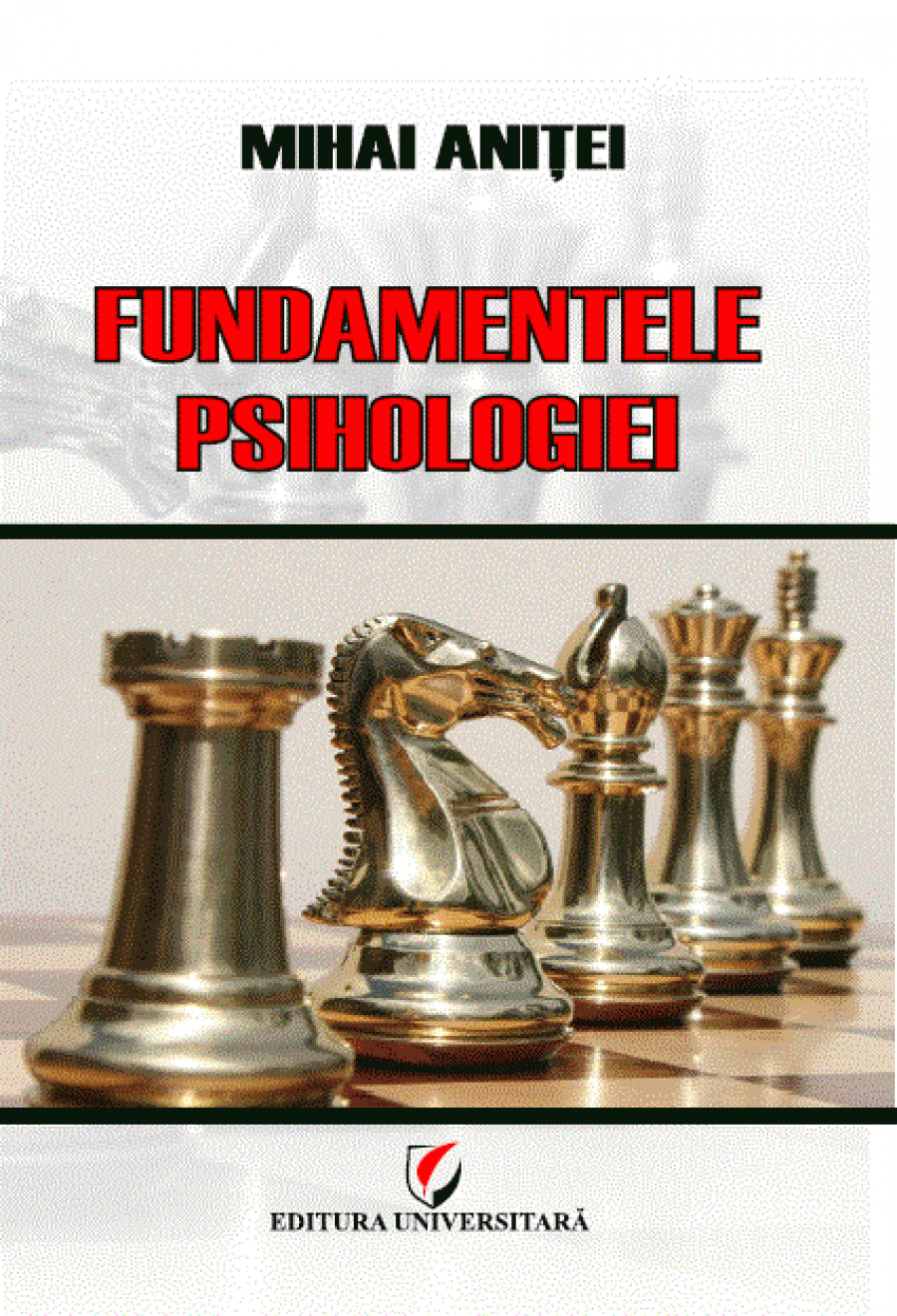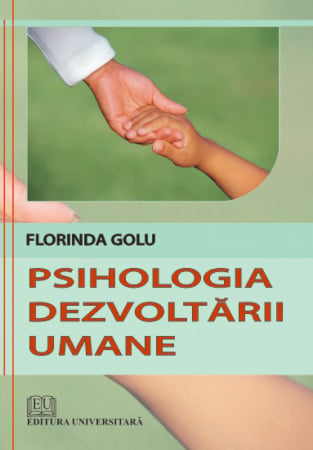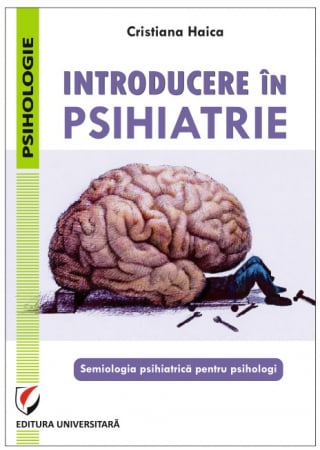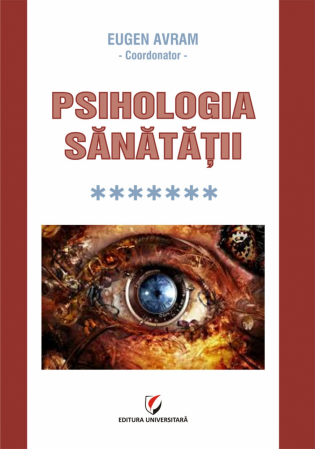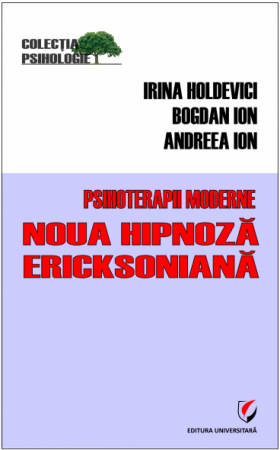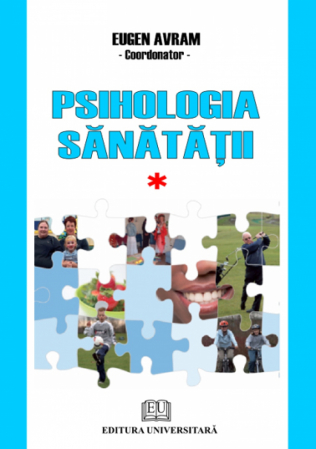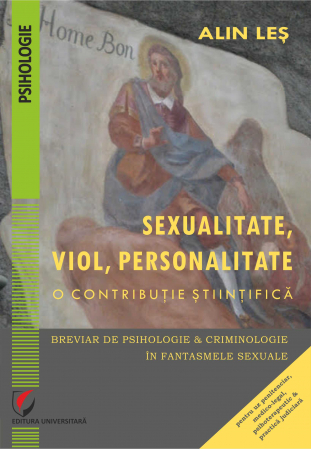Manuscript proposals: [email protected] / 0745 204 115 //// Tracking orders Individuals / Sales: 0745 200 357 / Orders Legal entities: 0721 722 783
ISBN: 978-606-28-1456-4
DOI: https://doi.org/10.5682/9786062814564
Publisher year: 2022
Edition: I
Pages: 254
Publisher: Editura Universitară
Author: Alin Les
Product Code:
9786062814564
Do you need help?
0745 200 357
- Description
- Download (1)
- Authors
- Content
- More details
- Reviews (0)
In the landscape, unfortunately, so poor of local literature in the field of Criminology, Alin Les's work on crime, criminal and criminality is more than welcome.
From the first lines, the author confesses to us that the work "combines an approach in both scientific and literary terms... and from this perspective it fits, according to the language of Baruch Spinoza, in what is called "scientific literature".
Indeed, the author constantly oscillates between the fiction and the scientific style, involving himself and the reader in the analysis of the consciousness processes of the contemporary man, who reaches the threshold of committing a criminal act and sometimes, unfortunately, transgresses it.
Through the way in which it tries to answer the extremely complex problems that such introspection implies, without - as Adrian Marino shows - imposing the answers on us and without dogmatizing them, the work presents itself as an essay of "more humane criminology" as as the author reveals himself.
Being an atypical work of criminology, its reading is not at all easy, the author constantly appeals to the fields from which Criminology was born, but also to those that he added along the way, as the sciences of human nature have progressed and diversified. Laudable in this regard is the author's ambition to add new dimensions to the highly prestigious interdisciplinary synthesis models made by the School of Criminology in Montreal, Louvain and beyond, which will contribute to the construction of a Romanian model. Without discouraging Alin Les, I am afraid that - in the only country in the European Union and probably among the few in the world where there is no scientific research structure in the field of Criminology, where only two years after its establishment, within the Ministry Justice, the National Institute of Criminology was disbanded abusively, in a guilty "silence" of all the actors involved directly (political decision-makers) or indirectly (the teaching and academic staff), and more recently in the same country, the only specialized magazine ( The Journal of Criminology, Criminalistics and Penology) is about to cease its publication - such an approach is, if not impossible, extremely difficult to achieve.
The work includes two parts. A general part called Pre-Criminology and criminological psychology which the author positions as an adjunct to the special part, in which phenomenology, anthropology, psychology represent the visionary frames for the author's explorations and a special part in which the universe "of the one who gets to pass to the act" is examined using the Diagnostic and Statistical Manual of Mental Disorders (DSM-4) as a starting point.
I can't help but notice the author's elegant, erudite style, but I warn the reader that understanding Alin Les's thoughts requires in-depth knowledge of human sciences.
I have no doubt that the author will continue his research, enriching with arguments and demonstrations the scientific side of his contributions to the development of Criminology and Criminological Psychology. Because the delinquent and the delinquent are - as noted by renowned researchers in the field of clinical criminology Diane Casoni and Louis Brunet - ultimately legal constructions, rather "than psychological or psychoanalytical conceptualizations, especially since an individual is not reducible to the sum the acts he commits".
Prof. Dr. Rodica Stanoiu
President of the Romanian Society of Criminology and Criminalistics
From the first lines, the author confesses to us that the work "combines an approach in both scientific and literary terms... and from this perspective it fits, according to the language of Baruch Spinoza, in what is called "scientific literature".
Indeed, the author constantly oscillates between the fiction and the scientific style, involving himself and the reader in the analysis of the consciousness processes of the contemporary man, who reaches the threshold of committing a criminal act and sometimes, unfortunately, transgresses it.
Through the way in which it tries to answer the extremely complex problems that such introspection implies, without - as Adrian Marino shows - imposing the answers on us and without dogmatizing them, the work presents itself as an essay of "more humane criminology" as as the author reveals himself.
Being an atypical work of criminology, its reading is not at all easy, the author constantly appeals to the fields from which Criminology was born, but also to those that he added along the way, as the sciences of human nature have progressed and diversified. Laudable in this regard is the author's ambition to add new dimensions to the highly prestigious interdisciplinary synthesis models made by the School of Criminology in Montreal, Louvain and beyond, which will contribute to the construction of a Romanian model. Without discouraging Alin Les, I am afraid that - in the only country in the European Union and probably among the few in the world where there is no scientific research structure in the field of Criminology, where only two years after its establishment, within the Ministry Justice, the National Institute of Criminology was disbanded abusively, in a guilty "silence" of all the actors involved directly (political decision-makers) or indirectly (the teaching and academic staff), and more recently in the same country, the only specialized magazine ( The Journal of Criminology, Criminalistics and Penology) is about to cease its publication - such an approach is, if not impossible, extremely difficult to achieve.
The work includes two parts. A general part called Pre-Criminology and criminological psychology which the author positions as an adjunct to the special part, in which phenomenology, anthropology, psychology represent the visionary frames for the author's explorations and a special part in which the universe "of the one who gets to pass to the act" is examined using the Diagnostic and Statistical Manual of Mental Disorders (DSM-4) as a starting point.
I can't help but notice the author's elegant, erudite style, but I warn the reader that understanding Alin Les's thoughts requires in-depth knowledge of human sciences.
I have no doubt that the author will continue his research, enriching with arguments and demonstrations the scientific side of his contributions to the development of Criminology and Criminological Psychology. Because the delinquent and the delinquent are - as noted by renowned researchers in the field of clinical criminology Diane Casoni and Louis Brunet - ultimately legal constructions, rather "than psychological or psychoanalytical conceptualizations, especially since an individual is not reducible to the sum the acts he commits".
Prof. Dr. Rodica Stanoiu
President of the Romanian Society of Criminology and Criminalistics
-
Criminology and criminological psychology: deviance, psychopathology, sexuality
Download
ALIN LES
About the author / 2
Contents / 5
Preface / 15
Preface to the revised and added edition / 17
Preface (1) to the revised and added edition / 21
Preface (2) to the revised and added edition / 23
Introduction / 25
Motto / 33
PART I
GENERAL PART
PRE-CRIMINOLOGY AND CRIMINOLOGY PSYCHOLOGY
Assertions and questions from the field of criminology and criminological psychology
Files 1 - 78
Handout 1. "Why?" / 38
Sheet 2. How death is our second name / 38
Sheet 3. Psychological seniority test / 39
Sheet 4. For autoretroceding axiological values / 39
File 5. The good feeling / 39
Sheet 6. Recommending a way of being non-psychopathological / 40
File 7. Temptation of delinquent states / 40
Sheet 8. More the other. Up to psycho-criminology, to the bar of one's own eye / 41
Sheet 9. "Good" emotion / 41
Sheet 10. Permanent self-education: from the possibility of refusal to the possibility of proximity to the act /42
File 11. "Deep disturbance" of the human condition / 42
Sheet 12. Thought 1; Gand 2 / 43
Sheet 13. About the dignity of behavior / 43
File 14. The phenomenon of moral parasitism. A premise of the prelude to the act: personality disorder / 44
Sheet 15. Defoliation as a psychological process of maturity / 44
Sheet 16. Thought 3; Gand 4 / 45
File 17. Psychological blockage / 45
Sheet 18. Loneliness - between reality and reverie / 46
File 19. Genius, reality and fantasy / 47
File 20. The common factor: "mal de vivre" / 48
Sheet 21. Responsibility as involvement / 48
Sheet 22. Non-psychoanalytic dream flow / 48
File 23. Ethics and deontologies in psychiatry / 49
Sheet 24. For living souls! / 50
File 25. About complexes and fears / 51
File 26. Criminal activity can be reduced / 52
File 27. Insistence and its dual character / 52
File 28. Is there a principle of privacy? / 52
File 29. Free time / 53
File 30. Pseudo / 53
File 31. Crime, crime and criminals / 54
File 32. Music - the therapist of violence / 54
Sheet 33. Degeneration / 54
File 34. Pornographic and educational obscenities / 55
File 35. Gand 5 / 55
File 36. Physical illness. Or about the "main character trait" of death / 56
File 37. Chronological age and the Ego of its stages / 56
File 38. Love. Or about the pantomime of forgotten gestures / 56
File 39. About evil / 58
Sheet 40. Delimitation of "You". Or about isolation in society / 58
File 41. Culture as an anti-crime sedative / 59
File 42. Putin from Pierre Gisel / 59
Sheet 43. Self-invitations for ascension / 60
File 44. Decisions / 60
File 45. The excess of one's own will and the lack through those of love, power and representation / 60
File 46. No education / 61
Sheet 47. Deviance as an intrinsic ability / 61
Sheet 48. Deviation syndrome / 62
Sheets 49.1 – 49.2. Thought 6; Gand 7 / 63
File 50. Syndrome of pawning the will / 63
File 51. Non-demagogic axes of the human subject / 63
Sheet 52. Premeditated waiting / 63
File 53. "Invisible" social deviance / 64
Sheet 54. Human depth / 64
File 55. The body from the phenomenological perspective: Enachescu's perspective. Or criminological psychology essay, phenomenological perspective (I) / 64
File 56. The body from the phenomenological perspective: Enachescu's perspective. Or criminological psychology essay, phenomenological perspective (II) / 66
File 57. Sickness: a psycho-social disease? / 69
File 58. The right to refuse / 69
File 59. Psychological sequestration / 69
File 60. "I-You" genuine. Or about the non-criminal blessing / 69
File 61. Fidelity as a positive norm / 71
File 62. Gand 8 / 71
File 63. Thought as already victim / 71
File 64. Situation with criminogenic potential / 71
Sheet 65. About the ability to be/remain/become yourself / 72
File 66. A little about "the other" / 72
File 67. The present as absent "disease" / 73
File 68. FBI internship and the Gibert Joseph Parisian bookstore / 73
File 69. Irrationality - demon of the day / 74
File 70. A shadow of the Ego of the Lacanian discourse / 74
Sheet 71. Reflection / 74
File 72. Psychiatry and opinions / 74
Sheet 73. Trust as a motivational factor / 75
File 74. Short review of adaptive psychopathology / 75
Sheet 75. Convenience of the uncomfortable / 75
File 76. For a criminological anthropo-phenomenology / 76
File 77. Hura: primitive self-indulgence? / 76
File 78. About Romanian culture, very briefly. Psychoanalysis, philosophy, psychology / 77
How to understand criminology in a post-communist capitalist-socialist society
Files 79 - 93
File 79. Laicity deferred to latent criminality / 81
File 80. The Cioaca case (I) / 81
File 81. The Cioaca case (II) / 82
File 82. Parents who criminalize / 88
File 83. "Polytheism" in criminology / 88
File 84. Road accidents - black criminology / 88
File 85. Between the criminology of Lombrossian atavism and cognitive criminology / 89
File 86. Criminological demonology / 89
File 87. Dermatology of deviance / 91
File 88. (Si) from Lombrosso reading / 91
File 89. Belief in the ideal does not fall within the scope of criminology / 92
File 90. Love - one of the answers of criminology (I) / 93
File 91. Love - one of the answers of criminology (II) / 93
File 92. Why discussing criminology starts in the family / 93
File 93. Debt and luxury. Why criminology here? / 94
How to understand (and become allies of) criminological psychology
Files 94 - 115
File 94. The human drug: parents / 98
File 95. Break in psycho-criminology / 99
File 96. Original sins - the first (psycho-)criminological outline? / 101
File 97. Darkness and time - psycho-criminological leitmotifs. Or the "decorations" that contribute to shaping the personality / 101
File 98. From affectivity to the logic of feelings / 102
File 99. Psychopathic moment / 103
File 100. Fragment of social pathology / 103
File 101. Psycho-criminology of one's own life - the expression of a "deviant deception"? / 104
File 102. Hegel in criminological psychology / 105
File 103. Everyday psychopathology. Or about aggression, violence and trauma / 105
File 104. Educational criminality - one of the destinations of psycho-criminology / 107
File 105. The swindler - criminogenic landmark / 108
File 106. Memory, repression, crime and psychoanalysis / 108
File 107. Family and deviant sexuality / 110
File 108. Victimization / 111
File 109. A lay psycho-criminological profile of the psychopath in Romanian society / 111
File 110. About perversion (I) / 113
File 111. About perversion (II) / 114
File 112. Trauma / 114
File 113. Loneliness can predispose psycho-criminologically / 115
File 114. How to contribute to the psycho-criminological archive / 115
Sheet 115. Manifestations of abuse / 115
The multi‑, inter‑ and transdisciplinary character of criminology and criminological psychology.
4.1. The sociology of lying
Files 116 - 132
Sheet 116. Lying and hormones of (in)sincerity / 118
Sheet 117. The lie in the agora of the relationship / 118
File 118. Lie and emotion / 118
File 119. "The will to lie": the philosophical flower / 118
File 120. The lie and the context / 119
File 121. The lie has a fluid character / 119
Sheet 122. Lie: between defense and attack / 119
Sheet 123. Lie and the Purpose of the Other / 120
Sheet 124. Lying and integrity / 120
File 125. What happens to the promise of a lie that is not honored? / 120
File 126. The evolution of lying on an aggressive basis / 121
Sheet 127. Lying and mental health / 121
Sheet 128. Lying and morality / 122
Sheet 129. The implications of lying in becoming / 122
Sheet 130. Truth or lie? / 122
File 131. Lying as an overcompensation mechanism / 124
File 132. Lying as an effect of overcrowding through evasion / 124
4.2. Psychoanalysis of lying
Files 133 – 139
File 133. Causality from the content of the lie / 125
Sheet 134. Lying and psychoanalysis / 125
File 135. Lying and self-deception / 125
Sheet 136. Self-sabotage is a perverse form of anxiety and lying / 126
File 137. Lying and affective ambivalence / 126
Sheet 138. Lying and neuroses versus psychoses / 126
Sheet 139. Lying as a stereotype / 127
4.3. Spirituality and the lie
Sheets 140 – 143
File 140. Lie and religion / 127
File 141. The first character of the lie / 127
File 142. The lie and the "state of truth" / 127
Sheet 143. Lie and deviation / 128
4.4. Lies and ethics
Files 144 - 147
Sheet 144. Ethics of lying / 128
File 145. Love and sex on the verge of psychopathology / 128
File 146. Vocation and the pathology of freedom. Psycho-criminological prelude / 131
File 147. Succeeded by failure - socially desired. Starting point for the objects of criminology and criminological psychology / 132
PART II
SPECIAL PART
CRIMINOLOGY AND CRIMINAL PSYCHOLOGY
The psychodynamic model: psychoanalysis and psychoanalytic psychology
Files 148‑160
File 148. Ghosts (I) / 138
File 149. Case study of conscious and unconscious phantasms in sexual psychopaths in the construction of the crime from the psychoanalytic perspective (II) / 138
File 150. Ghosts (III) / 151
File 151. The unconscious ghosts. Common point Freud and Klein (IV) / 151
File 152. Attachment, affectivity, inhibition / 151
File 153. "The Act" in Jacques Lacan / 152
File 154. The most used psychoanalytic defense mechanisms in criminological psychology / 153
File 155. Masochism and sadism. Jacques André perspective / 154
File 156. The other's desire for the other to commit suicide. Case of applied cultural psychoanalysis / 155
File 157. About the ghosts of criminals in the judicial investigation. Psycho-criminological Decalogue / 156
File 158. The sexual fantasies of the Romanians / 158
File 158.1. Sexuality: what you do, are, have / 158
Sheet 158.2. Psycho-education about rape and sexual fantasies / 159
Sheet 158.3. Scientific data reported on the Sexual Fantasies Evaluation Questionnaire (CEFS) in the normophilic male and female population / 159
Sheet 158.4. Sexual fantasies of normal men reported on the Sexual Fantasies Assessment Questionnaire. Pilot phase results – 107 items / 160
Sheet 158.5. Romanian sexuality according to the "Holiday" criterion / 160
Sheet 158.5.1. General data / 160
File 158.5.2. Pornhub & Romania. Back to 2014 / 161
File 159. Written defamation of a criminal / 161
Sheet 160. The struggle between the sexes and the deviance of the couple. Psychoanalytic and religious perspectives in support of the psycho-criminological one / 162
Paraphilias / deviant sexuality
Files 161‑162
File 161. Ondinism and urophilia - particularities of criminological psychology / 182
File 162. How do rapist sexual aggressors relate to sexual fantasies? / 182
Psychopathology
Files 163‑166
File 163.v From delinquent autism to DSM‑4: "Without another specification" / 186
File 164. The link between clinical criminology and clinical psychology and clinical psychopathology / 188
File 165. Elements of psychopathological semiology in adults and personality disorders / 189
File 166. The psycho-criminological profile of the terrorist. Psychology and psychopathology / 189
Personality disorders
Files 167‑170
File 167. Conceptual clarifications / 195
File 167.1. "Temperament", "behavior", "personality" / 195
File 168. Antisocial personality disorder / psychopathy / sociopathy / 196
File 168.1. Psychopathic as an attribute / 196
File 168.2. Who is the psychopath? (I) / 197
Sheet 168.3. Who is the psychopath? Or about consciousness, group and the absence of consciousness (II) / 197
File 168.4. Who is the psychopath? The psychopathic personality seen by Plagnol (III) / 198
Sheet 168.5. Who is the psychopath? About the narcissistic personality (IV) / 199
File 168.6. Who is the psychopath? Or about the limit personality (V) / 200
File 168.7. Who is the psychopath? Perspective Butoi (VI) / 201
File 168.8. Who is the psychopath? Butoi and Stout perspectives (VII) / 202
File 168.9. Who is the psychopath? The perspectives of Stephen Karpman and Miller (VIII) / 204
File 168.10. Psychopathy in society. Causes, dilemmas, answers/ solutions / 204
File 168.10.1. Psychopathy and its causes / 204
Sheet 168.10.2. The difference between psychopathy and aggression / 205
Sheet 168.10.3. Typologies of psychopaths / 205
Sheet 168.10.4. The psychopath and the obsession for the victim / 206
Sheet 168.10.5. The psychopath and love / 207
Sheet 168.10.6. Unmasking the psychopath and the effects on the victim / 207
Sheet 168.10.7. Can a psychopath be treated or hospitalized? / 207
Sheet 168.10.8. Credulity of the victim / 208
Sheet 168.10.9. The victim's relationship with the psychopath / 208
Sheet 168.10.10. Is there a "correct" manual reaction of the victim? / 209
Sheet 168.10.11. Life after psychopathy / 209
File 169. Juvenile delinquency / 210
File 169.1. Juvenile delinquency from the perspective of psycho-criminology (criminological psychology). The Sürig perspective / 210
File 170. Simulated behavior / lie / 211
Sheet 170.1. Lying and severe anxiety in a criminological/judicial/forensic context / 211
File 170.2. The psycho-social profile of the malignant lie / 212
File 170.3. the investigation of the simulated behavior through the polygraph technique in the investigation of the suspicion of rape on a child of 3 years and 6 months / 214
Sexual crimes
Files 171‑173
File 171. Sexual homicide / 224
File 172. Rape (in family/marital/partnership) – a scientifically proven social reality (evidence-based) through the evaluation of sexual fantasies in the Romanian population / 224
File 173. A typology of Romanian sexual aggressors. Scientifically validated study (evidence-based) in Romanian penitentiaries / 226
Crime, criminal, criminality
Files 174‑185
File 174. Relationship between mental disorder - state of danger - criminal behavior / 233
File 175. The hidden purpose of the crime / 234
File 176. The role of criminology in Denis Szabo / 235
File 177. Interdisciplinarity of conclusions / 235
File 178. Typological method in criminology / 236
File 179. Typology of delinquent / criminal behavior according to Marshall Barron Clinard / 237
File 180. Answer to an acclaimed Romanian criminologist / 230
File 181. Criminological point of view on the criminal. The perspective of Ioan Tanoviceanu / 238
File 182. Rape (in the family) / 240
File 183. Transference and countertransference, almost two verbal toys of the practice of some psychologists and psychiatrists. Or about their "blind omnipotence": the myth of professional invincibility / 240
File 184. Obstacles of criminology in Romania / 242
File 185. Cultural criminology – this "Corpus Christi" of civilized society / 243
Afterword / 245
Bibliographic references / 246
Contents / 5
Preface / 15
Preface to the revised and added edition / 17
Preface (1) to the revised and added edition / 21
Preface (2) to the revised and added edition / 23
Introduction / 25
Motto / 33
PART I
GENERAL PART
PRE-CRIMINOLOGY AND CRIMINOLOGY PSYCHOLOGY
Assertions and questions from the field of criminology and criminological psychology
Files 1 - 78
Handout 1. "Why?" / 38
Sheet 2. How death is our second name / 38
Sheet 3. Psychological seniority test / 39
Sheet 4. For autoretroceding axiological values / 39
File 5. The good feeling / 39
Sheet 6. Recommending a way of being non-psychopathological / 40
File 7. Temptation of delinquent states / 40
Sheet 8. More the other. Up to psycho-criminology, to the bar of one's own eye / 41
Sheet 9. "Good" emotion / 41
Sheet 10. Permanent self-education: from the possibility of refusal to the possibility of proximity to the act /42
File 11. "Deep disturbance" of the human condition / 42
Sheet 12. Thought 1; Gand 2 / 43
Sheet 13. About the dignity of behavior / 43
File 14. The phenomenon of moral parasitism. A premise of the prelude to the act: personality disorder / 44
Sheet 15. Defoliation as a psychological process of maturity / 44
Sheet 16. Thought 3; Gand 4 / 45
File 17. Psychological blockage / 45
Sheet 18. Loneliness - between reality and reverie / 46
File 19. Genius, reality and fantasy / 47
File 20. The common factor: "mal de vivre" / 48
Sheet 21. Responsibility as involvement / 48
Sheet 22. Non-psychoanalytic dream flow / 48
File 23. Ethics and deontologies in psychiatry / 49
Sheet 24. For living souls! / 50
File 25. About complexes and fears / 51
File 26. Criminal activity can be reduced / 52
File 27. Insistence and its dual character / 52
File 28. Is there a principle of privacy? / 52
File 29. Free time / 53
File 30. Pseudo / 53
File 31. Crime, crime and criminals / 54
File 32. Music - the therapist of violence / 54
Sheet 33. Degeneration / 54
File 34. Pornographic and educational obscenities / 55
File 35. Gand 5 / 55
File 36. Physical illness. Or about the "main character trait" of death / 56
File 37. Chronological age and the Ego of its stages / 56
File 38. Love. Or about the pantomime of forgotten gestures / 56
File 39. About evil / 58
Sheet 40. Delimitation of "You". Or about isolation in society / 58
File 41. Culture as an anti-crime sedative / 59
File 42. Putin from Pierre Gisel / 59
Sheet 43. Self-invitations for ascension / 60
File 44. Decisions / 60
File 45. The excess of one's own will and the lack through those of love, power and representation / 60
File 46. No education / 61
Sheet 47. Deviance as an intrinsic ability / 61
Sheet 48. Deviation syndrome / 62
Sheets 49.1 – 49.2. Thought 6; Gand 7 / 63
File 50. Syndrome of pawning the will / 63
File 51. Non-demagogic axes of the human subject / 63
Sheet 52. Premeditated waiting / 63
File 53. "Invisible" social deviance / 64
Sheet 54. Human depth / 64
File 55. The body from the phenomenological perspective: Enachescu's perspective. Or criminological psychology essay, phenomenological perspective (I) / 64
File 56. The body from the phenomenological perspective: Enachescu's perspective. Or criminological psychology essay, phenomenological perspective (II) / 66
File 57. Sickness: a psycho-social disease? / 69
File 58. The right to refuse / 69
File 59. Psychological sequestration / 69
File 60. "I-You" genuine. Or about the non-criminal blessing / 69
File 61. Fidelity as a positive norm / 71
File 62. Gand 8 / 71
File 63. Thought as already victim / 71
File 64. Situation with criminogenic potential / 71
Sheet 65. About the ability to be/remain/become yourself / 72
File 66. A little about "the other" / 72
File 67. The present as absent "disease" / 73
File 68. FBI internship and the Gibert Joseph Parisian bookstore / 73
File 69. Irrationality - demon of the day / 74
File 70. A shadow of the Ego of the Lacanian discourse / 74
Sheet 71. Reflection / 74
File 72. Psychiatry and opinions / 74
Sheet 73. Trust as a motivational factor / 75
File 74. Short review of adaptive psychopathology / 75
Sheet 75. Convenience of the uncomfortable / 75
File 76. For a criminological anthropo-phenomenology / 76
File 77. Hura: primitive self-indulgence? / 76
File 78. About Romanian culture, very briefly. Psychoanalysis, philosophy, psychology / 77
How to understand criminology in a post-communist capitalist-socialist society
Files 79 - 93
File 79. Laicity deferred to latent criminality / 81
File 80. The Cioaca case (I) / 81
File 81. The Cioaca case (II) / 82
File 82. Parents who criminalize / 88
File 83. "Polytheism" in criminology / 88
File 84. Road accidents - black criminology / 88
File 85. Between the criminology of Lombrossian atavism and cognitive criminology / 89
File 86. Criminological demonology / 89
File 87. Dermatology of deviance / 91
File 88. (Si) from Lombrosso reading / 91
File 89. Belief in the ideal does not fall within the scope of criminology / 92
File 90. Love - one of the answers of criminology (I) / 93
File 91. Love - one of the answers of criminology (II) / 93
File 92. Why discussing criminology starts in the family / 93
File 93. Debt and luxury. Why criminology here? / 94
How to understand (and become allies of) criminological psychology
Files 94 - 115
File 94. The human drug: parents / 98
File 95. Break in psycho-criminology / 99
File 96. Original sins - the first (psycho-)criminological outline? / 101
File 97. Darkness and time - psycho-criminological leitmotifs. Or the "decorations" that contribute to shaping the personality / 101
File 98. From affectivity to the logic of feelings / 102
File 99. Psychopathic moment / 103
File 100. Fragment of social pathology / 103
File 101. Psycho-criminology of one's own life - the expression of a "deviant deception"? / 104
File 102. Hegel in criminological psychology / 105
File 103. Everyday psychopathology. Or about aggression, violence and trauma / 105
File 104. Educational criminality - one of the destinations of psycho-criminology / 107
File 105. The swindler - criminogenic landmark / 108
File 106. Memory, repression, crime and psychoanalysis / 108
File 107. Family and deviant sexuality / 110
File 108. Victimization / 111
File 109. A lay psycho-criminological profile of the psychopath in Romanian society / 111
File 110. About perversion (I) / 113
File 111. About perversion (II) / 114
File 112. Trauma / 114
File 113. Loneliness can predispose psycho-criminologically / 115
File 114. How to contribute to the psycho-criminological archive / 115
Sheet 115. Manifestations of abuse / 115
The multi‑, inter‑ and transdisciplinary character of criminology and criminological psychology.
4.1. The sociology of lying
Files 116 - 132
Sheet 116. Lying and hormones of (in)sincerity / 118
Sheet 117. The lie in the agora of the relationship / 118
File 118. Lie and emotion / 118
File 119. "The will to lie": the philosophical flower / 118
File 120. The lie and the context / 119
File 121. The lie has a fluid character / 119
Sheet 122. Lie: between defense and attack / 119
Sheet 123. Lie and the Purpose of the Other / 120
Sheet 124. Lying and integrity / 120
File 125. What happens to the promise of a lie that is not honored? / 120
File 126. The evolution of lying on an aggressive basis / 121
Sheet 127. Lying and mental health / 121
Sheet 128. Lying and morality / 122
Sheet 129. The implications of lying in becoming / 122
Sheet 130. Truth or lie? / 122
File 131. Lying as an overcompensation mechanism / 124
File 132. Lying as an effect of overcrowding through evasion / 124
4.2. Psychoanalysis of lying
Files 133 – 139
File 133. Causality from the content of the lie / 125
Sheet 134. Lying and psychoanalysis / 125
File 135. Lying and self-deception / 125
Sheet 136. Self-sabotage is a perverse form of anxiety and lying / 126
File 137. Lying and affective ambivalence / 126
Sheet 138. Lying and neuroses versus psychoses / 126
Sheet 139. Lying as a stereotype / 127
4.3. Spirituality and the lie
Sheets 140 – 143
File 140. Lie and religion / 127
File 141. The first character of the lie / 127
File 142. The lie and the "state of truth" / 127
Sheet 143. Lie and deviation / 128
4.4. Lies and ethics
Files 144 - 147
Sheet 144. Ethics of lying / 128
File 145. Love and sex on the verge of psychopathology / 128
File 146. Vocation and the pathology of freedom. Psycho-criminological prelude / 131
File 147. Succeeded by failure - socially desired. Starting point for the objects of criminology and criminological psychology / 132
PART II
SPECIAL PART
CRIMINOLOGY AND CRIMINAL PSYCHOLOGY
The psychodynamic model: psychoanalysis and psychoanalytic psychology
Files 148‑160
File 148. Ghosts (I) / 138
File 149. Case study of conscious and unconscious phantasms in sexual psychopaths in the construction of the crime from the psychoanalytic perspective (II) / 138
File 150. Ghosts (III) / 151
File 151. The unconscious ghosts. Common point Freud and Klein (IV) / 151
File 152. Attachment, affectivity, inhibition / 151
File 153. "The Act" in Jacques Lacan / 152
File 154. The most used psychoanalytic defense mechanisms in criminological psychology / 153
File 155. Masochism and sadism. Jacques André perspective / 154
File 156. The other's desire for the other to commit suicide. Case of applied cultural psychoanalysis / 155
File 157. About the ghosts of criminals in the judicial investigation. Psycho-criminological Decalogue / 156
File 158. The sexual fantasies of the Romanians / 158
File 158.1. Sexuality: what you do, are, have / 158
Sheet 158.2. Psycho-education about rape and sexual fantasies / 159
Sheet 158.3. Scientific data reported on the Sexual Fantasies Evaluation Questionnaire (CEFS) in the normophilic male and female population / 159
Sheet 158.4. Sexual fantasies of normal men reported on the Sexual Fantasies Assessment Questionnaire. Pilot phase results – 107 items / 160
Sheet 158.5. Romanian sexuality according to the "Holiday" criterion / 160
Sheet 158.5.1. General data / 160
File 158.5.2. Pornhub & Romania. Back to 2014 / 161
File 159. Written defamation of a criminal / 161
Sheet 160. The struggle between the sexes and the deviance of the couple. Psychoanalytic and religious perspectives in support of the psycho-criminological one / 162
Paraphilias / deviant sexuality
Files 161‑162
File 161. Ondinism and urophilia - particularities of criminological psychology / 182
File 162. How do rapist sexual aggressors relate to sexual fantasies? / 182
Psychopathology
Files 163‑166
File 163.v From delinquent autism to DSM‑4: "Without another specification" / 186
File 164. The link between clinical criminology and clinical psychology and clinical psychopathology / 188
File 165. Elements of psychopathological semiology in adults and personality disorders / 189
File 166. The psycho-criminological profile of the terrorist. Psychology and psychopathology / 189
Personality disorders
Files 167‑170
File 167. Conceptual clarifications / 195
File 167.1. "Temperament", "behavior", "personality" / 195
File 168. Antisocial personality disorder / psychopathy / sociopathy / 196
File 168.1. Psychopathic as an attribute / 196
File 168.2. Who is the psychopath? (I) / 197
Sheet 168.3. Who is the psychopath? Or about consciousness, group and the absence of consciousness (II) / 197
File 168.4. Who is the psychopath? The psychopathic personality seen by Plagnol (III) / 198
Sheet 168.5. Who is the psychopath? About the narcissistic personality (IV) / 199
File 168.6. Who is the psychopath? Or about the limit personality (V) / 200
File 168.7. Who is the psychopath? Perspective Butoi (VI) / 201
File 168.8. Who is the psychopath? Butoi and Stout perspectives (VII) / 202
File 168.9. Who is the psychopath? The perspectives of Stephen Karpman and Miller (VIII) / 204
File 168.10. Psychopathy in society. Causes, dilemmas, answers/ solutions / 204
File 168.10.1. Psychopathy and its causes / 204
Sheet 168.10.2. The difference between psychopathy and aggression / 205
Sheet 168.10.3. Typologies of psychopaths / 205
Sheet 168.10.4. The psychopath and the obsession for the victim / 206
Sheet 168.10.5. The psychopath and love / 207
Sheet 168.10.6. Unmasking the psychopath and the effects on the victim / 207
Sheet 168.10.7. Can a psychopath be treated or hospitalized? / 207
Sheet 168.10.8. Credulity of the victim / 208
Sheet 168.10.9. The victim's relationship with the psychopath / 208
Sheet 168.10.10. Is there a "correct" manual reaction of the victim? / 209
Sheet 168.10.11. Life after psychopathy / 209
File 169. Juvenile delinquency / 210
File 169.1. Juvenile delinquency from the perspective of psycho-criminology (criminological psychology). The Sürig perspective / 210
File 170. Simulated behavior / lie / 211
Sheet 170.1. Lying and severe anxiety in a criminological/judicial/forensic context / 211
File 170.2. The psycho-social profile of the malignant lie / 212
File 170.3. the investigation of the simulated behavior through the polygraph technique in the investigation of the suspicion of rape on a child of 3 years and 6 months / 214
Sexual crimes
Files 171‑173
File 171. Sexual homicide / 224
File 172. Rape (in family/marital/partnership) – a scientifically proven social reality (evidence-based) through the evaluation of sexual fantasies in the Romanian population / 224
File 173. A typology of Romanian sexual aggressors. Scientifically validated study (evidence-based) in Romanian penitentiaries / 226
Crime, criminal, criminality
Files 174‑185
File 174. Relationship between mental disorder - state of danger - criminal behavior / 233
File 175. The hidden purpose of the crime / 234
File 176. The role of criminology in Denis Szabo / 235
File 177. Interdisciplinarity of conclusions / 235
File 178. Typological method in criminology / 236
File 179. Typology of delinquent / criminal behavior according to Marshall Barron Clinard / 237
File 180. Answer to an acclaimed Romanian criminologist / 230
File 181. Criminological point of view on the criminal. The perspective of Ioan Tanoviceanu / 238
File 182. Rape (in the family) / 240
File 183. Transference and countertransference, almost two verbal toys of the practice of some psychologists and psychiatrists. Or about their "blind omnipotence": the myth of professional invincibility / 240
File 184. Obstacles of criminology in Romania / 242
File 185. Cultural criminology – this "Corpus Christi" of civilized society / 243
Afterword / 245
Bibliographic references / 246
8 years have passed since the launch of the first edition, in an honorable environment at that time: the Romanian Academy. From our own resources, 100 copies were printed. The book went unnoticed in the specialty landscape, but it sold relatively quickly. From where I conclude that the interest exists and is doubled from behind the curtain by the novelties of the perspectives.
Criminology in Romania is not doing well at all. The phenomenon is well-known, it doesn't need to be mentioned anymore. But what I want to highlight is that the focus on evidence-based criminology is almost non-existent. Treaties in the field of criminal law do not converge towards an exhaustive integration of novelties in related fields because, on the one hand, they do not exist, or they are not sufficiently visible. I remain convinced that the status of criminology is intentionally disorientated, because there is a lot of work to be done on its preventive side. With a few very few exceptions, criminology remains the professional spring preferred by French-speaking specialists in particular.
The 2nd edition started from the need to expose some realities observed over time: 1. the path of criminology and criminological psychology in the world; 2. evidence-based in criminology and criminological psychology becomes and is a certainty, which can provide a clearer picture of some conceptual or professional realities; 3. The National Institute of Criminology is a paradox; 4. we do not have, except sporadically, a cognitive infrastructure and a critical-constructive vision in the judicial and criminal space; 5. the vast majority of NGOs in the field have only an apparent concern for the new and the "judicialization" of specialists' minds; 6. the teachers, in their vast majority - are often out of step with the current state of research and teach or guide their courses based on plagiarized or quasi-plagiarized works; 7. professional institutions in Romania have in the hiring/recruitment competition bibliography works of so-called specialists, who have plagiarized, below the current level of information; 8. the promotion in the INM curriculum of some pseudo-disciplines - scientific (see NLP), which would help to understand the mechanisms behind a courtroom; 9. the public approach, at the local level, of some false topics of interest at the national level, strictly with "local" specialists from the justice system: "women in justice" versus "men in justice"; 10. the simulated behavior in sexual offenses through the polygraph technique should be supervised by professionally honest experts, with experience and a positive character; 11. we the necessity of introducing the status of expert for determined periods (see the Canada model).
The novelties brought to this edition consist, in a first phase, in the reconfiguration of the contents. It is more organized, more disciplined, more mathematical, for the 21st century brain that wants to know, punctually, the details of X or Y subject of interest. One section does not depend on another, except to the extent that you want to read the entire content. But as time plays tricks on us, it is important to go directly to the content that interests you. In particular, the one related to the news regarding sexually motivated crimes resulting from some studies on the territory of our country.
In the general part, we have included four new sections: 1. Assertions and questions from the field of criminology and criminological psychology; 2. How to understand criminology in a post-communist capitalist-socialist society; 3. How to understand (and ally with) criminological psychology; 4. The multi‑, inter‑ and transdisciplinary character of criminology and criminological psychology, with the four dimensions: a) sociology of lying; b) psychoanalysis of lying; c) spirituality and lying; d) lying and ethics. I reconsidered that part of what I presented in the special part should rather be in the general part. For example: Love and sex on the threshold of psychopathology, Vocation and the pathology of freedom. Psycho-criminological prelude and Success through social-desired failure. Starting camp in psycho-criminology. Also, for the image of an authentic compendium on the matter in time, I decided to add - with the permission of the publisher - the text from "Despre minciuna. Social, psychoanalytic, spiritual, ethical, criminological-judicial reasons". Thus, the general part includes social reasons (with the exception of the psycho-social profile of the malignant lie, found in the special part), psychoanalytical, ethical and spiritual. The special part is completed, in this sense, with Lying and severe anxiety in a criminological/judicial/forensic context.
The special part is also segmented into 6 chapters. The only chapter that is in turn divided into 4 subchapters is the one related to personality disorders: conceptual clarifications, antisocial personality disorder/psychopathy/sociopathy, juvenile delinquency and simulated behavior/lying. Practically, we have offered a brighter and rarer panel of understanding of this fascinating field of the criminal phenomenon.
The special part begins with the chapter The psychodynamic model: psychoanalysis and psychoanalytic psychology, here including the latest news, in short, in the field of Romanian sexuality in terms of what men and women fantasize about. I continued with the chapter "Paraphilias/ deviant sexuality" in which I included the subchapter: 1. How do rapist sexual aggressors relate to sexual fantasies?. In the "Personality disorders" chapter, we considered the introduction of at least two novelties: 1. The psycho-social profile of the malignant lie, respectively 2. The investigation of simulated behavior through the polygraph technique in the investigation of the suspicion of rape on a 3- and 6-year-old child months. The next chapter is dedicated to psychopathology, which promises to be significantly improved in future editions. An essential chapter for such a manual is "Sexual crimes". Here I have included two pressing themes: 1. Rape (family/marital/partneral) – a scientifically proven reality (evidence-based) through the evaluation of sexual fantasies in the Romanian population and 2. A typology of Romanian rapist sexual aggressors. Scientifically validated study (evidence-based) in Romanian penitentiaries. In the last chapter, "Crime, criminal, criminality", the novelty element is cultural Criminology - this "Corpus Christi" of civilized society.
The citation in the text has also changed. In this edition, the citation rule is according to the latest regulations of the APA (American Psychological Association). Footnotes are intended to bring clarifications and clarifications regarding a theme or a treated subject.
Author
Criminology in Romania is not doing well at all. The phenomenon is well-known, it doesn't need to be mentioned anymore. But what I want to highlight is that the focus on evidence-based criminology is almost non-existent. Treaties in the field of criminal law do not converge towards an exhaustive integration of novelties in related fields because, on the one hand, they do not exist, or they are not sufficiently visible. I remain convinced that the status of criminology is intentionally disorientated, because there is a lot of work to be done on its preventive side. With a few very few exceptions, criminology remains the professional spring preferred by French-speaking specialists in particular.
The 2nd edition started from the need to expose some realities observed over time: 1. the path of criminology and criminological psychology in the world; 2. evidence-based in criminology and criminological psychology becomes and is a certainty, which can provide a clearer picture of some conceptual or professional realities; 3. The National Institute of Criminology is a paradox; 4. we do not have, except sporadically, a cognitive infrastructure and a critical-constructive vision in the judicial and criminal space; 5. the vast majority of NGOs in the field have only an apparent concern for the new and the "judicialization" of specialists' minds; 6. the teachers, in their vast majority - are often out of step with the current state of research and teach or guide their courses based on plagiarized or quasi-plagiarized works; 7. professional institutions in Romania have in the hiring/recruitment competition bibliography works of so-called specialists, who have plagiarized, below the current level of information; 8. the promotion in the INM curriculum of some pseudo-disciplines - scientific (see NLP), which would help to understand the mechanisms behind a courtroom; 9. the public approach, at the local level, of some false topics of interest at the national level, strictly with "local" specialists from the justice system: "women in justice" versus "men in justice"; 10. the simulated behavior in sexual offenses through the polygraph technique should be supervised by professionally honest experts, with experience and a positive character; 11. we the necessity of introducing the status of expert for determined periods (see the Canada model).
The novelties brought to this edition consist, in a first phase, in the reconfiguration of the contents. It is more organized, more disciplined, more mathematical, for the 21st century brain that wants to know, punctually, the details of X or Y subject of interest. One section does not depend on another, except to the extent that you want to read the entire content. But as time plays tricks on us, it is important to go directly to the content that interests you. In particular, the one related to the news regarding sexually motivated crimes resulting from some studies on the territory of our country.
In the general part, we have included four new sections: 1. Assertions and questions from the field of criminology and criminological psychology; 2. How to understand criminology in a post-communist capitalist-socialist society; 3. How to understand (and ally with) criminological psychology; 4. The multi‑, inter‑ and transdisciplinary character of criminology and criminological psychology, with the four dimensions: a) sociology of lying; b) psychoanalysis of lying; c) spirituality and lying; d) lying and ethics. I reconsidered that part of what I presented in the special part should rather be in the general part. For example: Love and sex on the threshold of psychopathology, Vocation and the pathology of freedom. Psycho-criminological prelude and Success through social-desired failure. Starting camp in psycho-criminology. Also, for the image of an authentic compendium on the matter in time, I decided to add - with the permission of the publisher - the text from "Despre minciuna. Social, psychoanalytic, spiritual, ethical, criminological-judicial reasons". Thus, the general part includes social reasons (with the exception of the psycho-social profile of the malignant lie, found in the special part), psychoanalytical, ethical and spiritual. The special part is completed, in this sense, with Lying and severe anxiety in a criminological/judicial/forensic context.
The special part is also segmented into 6 chapters. The only chapter that is in turn divided into 4 subchapters is the one related to personality disorders: conceptual clarifications, antisocial personality disorder/psychopathy/sociopathy, juvenile delinquency and simulated behavior/lying. Practically, we have offered a brighter and rarer panel of understanding of this fascinating field of the criminal phenomenon.
The special part begins with the chapter The psychodynamic model: psychoanalysis and psychoanalytic psychology, here including the latest news, in short, in the field of Romanian sexuality in terms of what men and women fantasize about. I continued with the chapter "Paraphilias/ deviant sexuality" in which I included the subchapter: 1. How do rapist sexual aggressors relate to sexual fantasies?. In the "Personality disorders" chapter, we considered the introduction of at least two novelties: 1. The psycho-social profile of the malignant lie, respectively 2. The investigation of simulated behavior through the polygraph technique in the investigation of the suspicion of rape on a 3- and 6-year-old child months. The next chapter is dedicated to psychopathology, which promises to be significantly improved in future editions. An essential chapter for such a manual is "Sexual crimes". Here I have included two pressing themes: 1. Rape (family/marital/partneral) – a scientifically proven reality (evidence-based) through the evaluation of sexual fantasies in the Romanian population and 2. A typology of Romanian rapist sexual aggressors. Scientifically validated study (evidence-based) in Romanian penitentiaries. In the last chapter, "Crime, criminal, criminality", the novelty element is cultural Criminology - this "Corpus Christi" of civilized society.
The citation in the text has also changed. In this edition, the citation rule is according to the latest regulations of the APA (American Psychological Association). Footnotes are intended to bring clarifications and clarifications regarding a theme or a treated subject.
Author
If you want to express your opinion about this product you can add a review.
write a review

6359.png)
![Criminology and criminological psychology: deviance, psychopathology, sexuality - Alin Les [1] Criminology and criminological psychology: deviance, psychopathology, sexuality - Alin Les [1]](https://gomagcdn.ro/domains/editurauniversitara.ro/files/product/large/553538.jpg)
